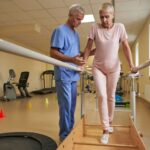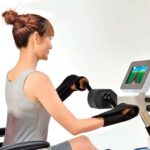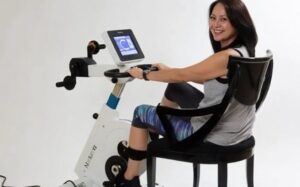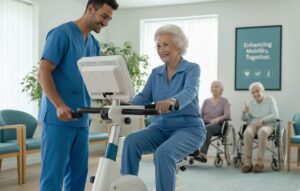
For patients dealing with Multiple Sclerosis, incorporating physical activity into their daily maintenance plan can be a daunting task. When any condition causes movement to feel difficult, strained or painful it can be easy to want to avoid it altogether. However, there are significant benefits for Multiple Sclerosis patients to include a level of movement into their days. Using tools like an active/passive cycle trainer and an arm ergometer can be a significant help in this process.
What is Multiple Sclerosis?
Multiple Sclerosis (MS) is an autoimmune disease that can significantly affect mobility and cause tremors, fatigue and muscle weakness in sufferers. This can lead to problems with spasticity, balance, walking and even cognitive and mental health.
Patients with MS often reduce their physical activity as a by-product of their increasing issues, and a fear of worsening their symptoms. However, inactivity often has the opposite effect. Reducing muscle movement and exercise can actually lead to increased muscle spasms and tightness as well as decreased mobility.
Exercise is beneficial for MS patients
The MedupV2 is an ergometer that provides arm and leg cycle therapy ideally suited for MS patients. Therapy that includes daily use promotes the well being of patients of varying degrees of disability. See more features sand health benefits!
While regular movement starts to get more restricted and difficult as the disease progresses, studies have shown that engaging in daily strength and aerobic activity can help with symptom management, muscle strength, mobility and overall quality of life.
Although the many symptoms associated with MS often leave patients uninterested in exercising daily, side effects of reduced mobility indicate that there is value in maintaining even the smallest amount of activity.
Cycle training is an effective tool
An active passive cycle trainer helps the user to maintain a regular exercise routine, even on days that they might struggle to do so. With various settings, including a fully passive mode, a cycle trainer is the perfect tool for anyone looking to incorporate activity into their days. Able to be used completely unsupervised and in your own home, a cycle trainer like the MedUp V2 eliminates many of the barriers that can get in the way of daily exercise.
Some of the top reasons to incorporate a cycle trainer into a daily routine for MS patients include:
Safe to use unsupervised – With safety features like a sturdy base and the built-in spasm recognition software, even users with balance issues and muscle spasms will be protected, allowing them to use the trainer without someone directly supervising them.
Variety of programs – For MS patients who are still able to perform exercises on their own, the active program can help to maintain muscle strength and mobility, while the assisted or passive mode helps the user to use muscles that they may struggle to use on their own.
Helps improve function and reduce symptoms – Maintaining daily activity with an active/passive cycle trainer can help improve limb function, leading to better walking ability. It can also reduce the muscle spasms and spasticity that can come with the decreased use of muscles.
Improves heart health – Regular aerobic activity like using a cycle trainer or arm ergometer forces the heart muscle to work harder than it would normally, which can result in a reduced risk of heart disease and high blood pressure, both common in patients with MS.
An ergometer is perfect for the upper body
In the same way that a cycle trainer can work a patient’s lower body, an arm ergometer works on the upper body. MS sufferers will experience stiffness and discomfort in all limbs, so spending time on both lower and upper body will offer the most opportunity for maintenance and improvement.
An arm ergometer uses both passive and active support in order to guide the patient through a repetitive cycle motion. This resistance training can help patients improve their heart health, endurance and upper body strength.
Flexibility exercises reduce spasticity
The muscle contractions and tightness that are characteristic of spasticity are often painful and prohibitive, however light movement and stretching can actually help reduce the spasms. A cycle trainer can help implement a low stress stretching routine that can improve flexibility and reduce spasticity over time.
Regular exercise is essential for MS patients
For anyone dealing with Multiple Sclerosis it may feel more natural to listen to their body and reduce the amount of physical activity they take on each day. However, there are many reasons why maintaining some daily movement is beneficial, and patients are likely to notice an improvement in mobility and a reduction in symptoms if they keep up with a routine that includes some exercise.




